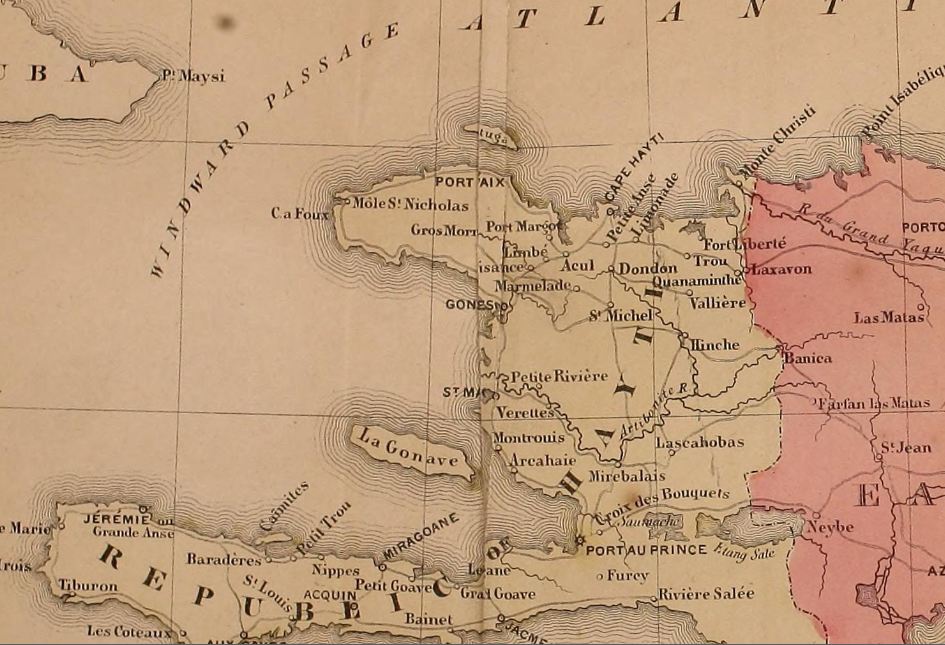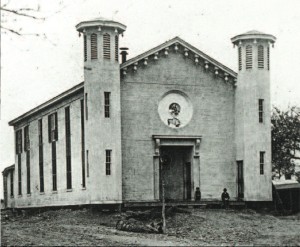By Carolyn B. Ivanoff with Mary J. Mycek and Marian K. O’Keefe for Connecticut Explored
On June 5, 1869, on a hot day in New York City, 36-year-old Connecticut native Ebenezer D. Bassett (1833-1908) and his family boarded the steamship The City of Port-au-Prince. Surrounded by a crowd of dignitaries and on-lookers who wished him well, Bassett embarked on a historic journey to the world’s only independent black republic, Haiti. (Or, as it was spelled in the 19th century, Hayti.) He had been appointed by the Grant administration as minister resident, our nation’s first black ambassador.
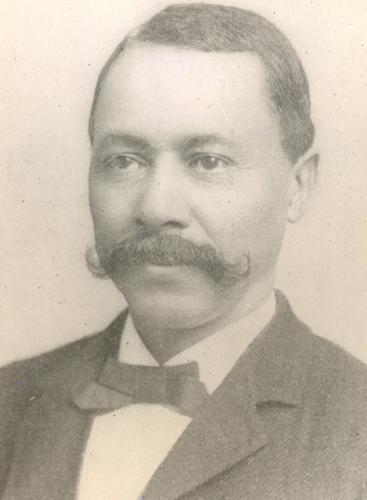
Ebenezer Bassett, Minister to Haiti and the Dominican Republic (1869-1879) – US Diplomacy Center at the US Department of State
The United States was in the midst of Reconstruction after a devastating Civil War. As Bassett boarded the ship, he was aware that he was breaking historic ground as the first black American appointed to a top diplomatic post. He acknowledged the risk of failure and the difficult diplomatic challenges that lay ahead. A few days earlier, he had addressed a large audience in New York City pledging to President Grant and the nation that he would bring to his work “An honest heart, a generous purpose, and unflagging industry, and an elevated patriotism.”
The Bassett Family
Bassett’s great-grandfather Pero had endured the Middle Passage to the New World as a slave. Pero had married Hagar, another enslaved African, who Reverend Richard Mansfield of Derby owned. One of Pero and Hagar’s sons, Tobiah (Bassett’s grandfather), was sold to John Wooster of Oxford; Tobiah won his freedom through his service in the American Revolution. Tobiah had a reputation for honor and intelligence in both the white and black communities and was elected a black governor, an honorary leadership position, by the black community of Derby in 1815. Tobiah’s son, Eben Tobias, was Bassett’s father. Eben Tobias elected and served as a black governor from 1840 to 1845. He married Susan Gregory Bassett and used the Bassett surname. Bassetts, white and black, populated the lower Naugatuck Valley, and the family may have chosen the Bassett name for reasons of kinship. Around 1830 or 1831 the couple moved to the Litchfield area, presumably for economic opportunity. They had three children: Charlotte in 1832, Ebenezer Don Carlos on October 16, 1833, and Napoleon in 1836. Sometime before the 1850s the family returned to the lower Naugatuck Valley and farmed land on Great Hill along the banks of the Housatonic River belonging to Dr. Martin Bull Bassett of Derby.
Educating Ebenezer
In the late 1840s Ebenezer’s formal education began at the Birmingham Academy established in 1838 and located near the Derby green. Though Connecticut had passed a gradual emancipation law in 1784, slavery was not abolished until 1848. Unlike other towns in the state, Derby did not exclude Bassett from an education because of his race. Reflecting on this period, Bassett later said, “My success in life I owe greatly to that American sense of fairness which was tendered me in old Derby, and which exacts that every man whether white or black, shall have a fair chance to run his race in life and make the most of himself.”
While attending school at the Birmingham Academy, Bassett was working in the office and running errands for the most prominent citizen in town, Dr. Ambrose Beardsley, who recognized Bassett’s academic talent. It was probably through Beardsley’s recommendation that Bassett attended the Wesleyan Academy in Wilbraham, Massachusetts (now the Wilbraham and Monson Academy). Wesleyan Academy was a stop on the Underground Railroad, and undoubtedly it was here Bassett saw the injustices of antebellum America that would culminate in Civil War. Bassett next attended the State Normal School in New Britain, now Central Connecticut State University. He graduated in 1853, the first and only black person in his class. Ebenezer Bassett had quietly, diplomatically, and astonishingly broken the color barrier in education in Connecticut.
After graduation, Bassett began his career as a teacher at the Whiting School, which was for children of color, in New Haven at a salary of $300 a year. After his first year, the school board’s report noted that Bassett had “transformed 40 or 50 thoughtless, reckless, tardy and reluctant youngsters into intelligent ambitious, well-disciplined and well-behaved students.” Hungry to continue his education, he attended classes at Yale in mathematics and classics. In 1855 he married Eliza Park in New Haven. While in New Haven he also met Frederick Douglass for the first time. Their lives would intersect many times in subsequent years, and their friendship would last until Douglass’s death.
Philadelphia Years
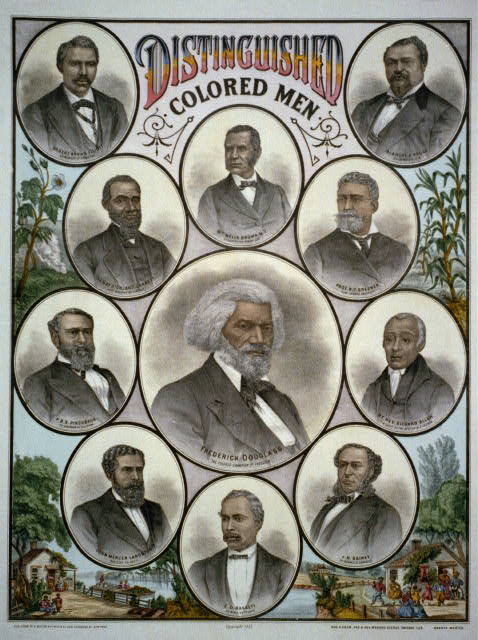
Distinguished Colored Men, A. Muller & Co., ca. 1883, chromolithograph. Note Ebenezer Bassett pictured directly under Frederick Douglass – Library of Congress, Prints and Photographs Division
In 1855 Bassett became principal of the Institute for Colored Youth (ICY) in Philadelphia (now Cheyney University). This prestigious appointment doubled his salary. ICY was then the nation’s flagship institution of black education and the Bassets became members of the black elite in Philadelphia. Basset became active in abolitionist efforts and was in constant touch with Frederick Douglass.
During the Civil War, Bassett actively recruited black soldiers, often standing beside Douglass on the podium. During and after the war, Bassett, who did not serve in the military, was involved in civil rights, nationally recognized as a pioneer black educator, and was active in Republican politics. His experience made him a perfect fit for the post of minister resident (the term “ambassador” did not come into use until 1893) to the newly recognized black republic of Haiti, which the Grant administration was determined to fill with a “worthy” black man.
Haiti
Haiti was a Caribbean nation on the western side of the island of Hispaniola (the eastern two-thirds of which were occupied by the Dominican Republic) that had been claimed by Columbus on behalf of Spain in 1492 and by the French in the 1660s. By 1790 Haiti had overshadowed the eastern part of the island to become the “Pearl of the Antilles,” the richest French colony in the New World, producing sugar, coffee, and indigo under the intense brutality of the French plantation system. Under the French system, it was cheaper to work a slave to death and purchase a new one than to care for existing workers. French plantation owners imported 30,000 to 100,000 slaves annually during more than a century of domination from 1697 to 1804.
Haiti’s enslaved people struggled with revolt, civil war, and foreign invasion. Inspired by the American and French revolutions and led by Toussaint L’Overture, a formerly enslaved coachman and genius of guerrilla warfare, Haiti was brought under black control. Napoleon invaded in 1802 in hopes of using Haiti as a platform to create a French empire in the New World. The superior Haitian army fought under L’Overture until L’Overture’s betrayal by his chief lieutenant, Jean-Jacques Dessalines, and his death in a French dungeon in 1802. Despite that loss, the French invaders were decimated and finally driven out by the slave armies, yellow fever, and the jungle. Nearly 80,000 Haitians perished in the conflict, but the Haitian forces had defeated one of Europe’s finest armies in the first successful slave revolt in world history. On January 1, 1804, Haiti proclaimed independence, becoming the second independent republic in the western hemisphere and the first free black republic in the world.
Bassett Becomes US Ambassador to Haiti
As a free republic, Haiti provided the US with a valuable trade. But for racial reasons the US refused to recognize the country diplomatically until 1862, under the Lincoln administration. When President Grant sought a US ambassador to Haiti in 1869, Bassett was endorsed by prominent Republicans for the post and submitted his name for consideration. His credentials as an educator, linguist, and activist made him a perfect fit for the post, and the Senate confirmed his appointment unanimously.
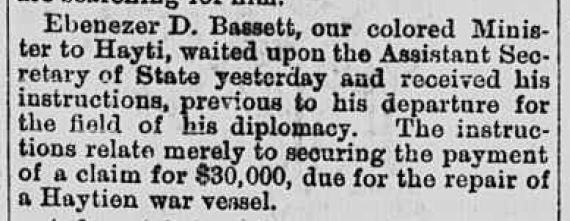
News clipping from South Carolina’s newspaper The Daily Phoenix, May 26, 1869 – Library of Congress, Chronicling America, Historic American Newspapers
By the time Bassett accepted his diplomatic post in 1869, Haiti, the former Pearl of the Antilles, had fallen into a pattern of disaster after disaster, facing revolution, revolt, and civil war followed by famine, disease, earthquake, and hurricanes. When Bassett landed on the island after a tempestuous sea voyage, Haiti was in the midst of yet another one of its violent civil wars. He found himself the most powerful American on the island, yet his proper French did not equip him to communicate in the Creole that was the language of the island, and he lacked diplomatic experience. One of the first things he did was to lease a fireproof building for his records to protect them from the violence of the on-going civil war.
Bassett served as minister resident for almost nine years of Haitian turmoil and trial. His diplomatic efforts were made extremely delicate due to the desire of the US to annex the Dominican Republic. Bassett had to repeatedly allay Haitian suspicions of a US takeover to protect American merchants and interests on the island. In the midst of all this, he carried on with his personal life; three of his eight children were born on the island, and two died there. Haiti, despite its travails, could be a deceptively lovely, tropical paradise, and Bassett came to love the island’s beauty.
During his tenure, Bassett proved a pioneer in providing political asylum and protecting human rights, often angering his superior, Secretary of State Hamilton Fish, and creating tension with Washington. Bassett regularly granted asylum to refugees under the auspices of the US compound at a time when political asylum and human rights were not of widespread concern; nor was this practice common among other diplomats. Fish believed that Bassett had no legal basis for accepting refugees into the US compound. Bassett often risked his own safety and that of his family in doing so. But Bassett saved many lives through this controversial practice, including that of General Boisrond-Canal, who later became president of Haiti, twice. One of the elements that played in Bassett’s favor was the slowness of communications. Dispatches had to be sent by ship and took weeks. Bassett often found it expedient to do what he felt was right and ask for forgiveness after the fact. Boisrond-Canal and other future leaders who Bassett saved would later hold him, and the US, in high esteem.
Bassett Returns to the US
As was customary, at the end of the Grant administration Bassett turned in his resignation, though he hoped the new administration would reinstate him. The Hayes administration appointed another black man, John M. Langston, who had been born a slave in Virginia, earned his freedom, and was serving as dean of Howard Law School. Langston was rewarded with the diplomatic post for his work on behalf of the Republican Party and the new president and fellow Ohioan, Hayes.
Bassett, at 44, found himself unemployed. On December 1, 1877, he and his family boarded the steamship Atlas for the two-week trip from Haiti to New York City. Back in New Haven, Bassett reengaged himself in public speaking and in political and civil rights issues. Bassett would never receive another US diplomatic appointment, but he was not forgotten in Haiti. In 1879, Haitian President Lysius Solomon, who brought some stability to Haiti, appointed Bassett Haitian consul in New York City. Bassett held that position until 1889, when he resigned in protest because American merchant ships were illegally running arms to Haitian rebels.
A New Post as Secretary to Frederick Douglass
In 1888, with Benjamin Harrison’s election as president, Bassett felt the time was ripe to seek his former post, but Frederick Douglass was offered the job. Bassett heartily supported the appointment and signed on as Douglass’s secretary. By this time, Douglass was elderly, he had no diplomatic experience, and he could not speak French. His tenure was not entirely successful, and he resigned in 1891, leaving Bassett again unemployed.
Returning to Connecticut, he went back to his old avocation of speaking about civil rights and Republican politics. Benjamin Harrison lost to Democrat Grover Cleveland in 1892; the nation fell further into the grip of Jim Crow, and Bassett fell ever deeper in debt. Eliza, Bassett’s beloved wife of 40 years, died in August 1895. Douglass also died in 1895, ending an era for the nation and a life-long friendship for Bassett.
In 1898, with the outbreak of the Spanish-American War, Haiti again feared annexation by the US. Bassett was appointed vice consul general by the Haitian government and held the position until his death.
Bassett passed quietly from life and the public eye in 1908 at his home in Brooklyn, New York. He, Eliza, and all of his children, several of whom had followed him into the field of education, lie together in the family plot in Grove Street Cemetery in New Haven. Largely forgotten today, Ebenezer D. Bassett triumphed over the obstacles of race and inequality in the 19th century to live an exemplary life devoted to educating and serving others as a pioneer black educator, the first black diplomat of the United States, and a quiet American hero.
Carolyn Ivanoff is a housemaster at Shelton Intermediate School who frequently writes and lectures on American history. She thanks Mary J. Mycek and Marian K. O’Keefe for their assistance with this article. Ivanoff, Mycek, and O’Keefe are authors of the 2008 publication Ebenezer D. Bassett (1833-1908) and a companion educational resource booklet for teachers and students.
© Connecticut Explored. All rights reserved. This article originally appeared in Connecticut Explored (formerly Hog River Journal ) Vol. 10/ No. 1, WINTER 2011/2012.
Note: ConnecticutHistory.org does not edit content originally published on another platform and therefore does not update any instances of outdated content or language.





